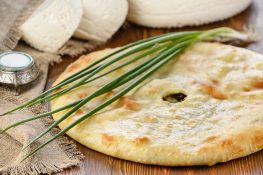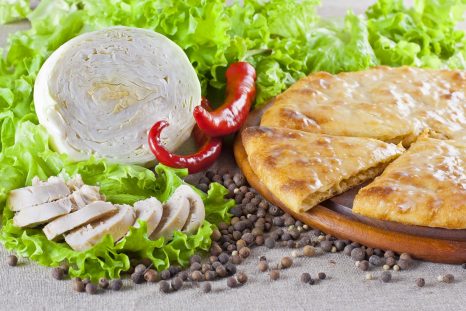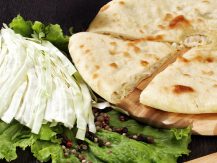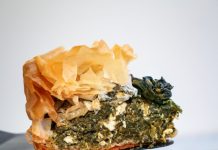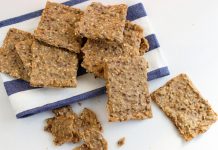The Ossetian pie is prepared according to a simple recipe, but it gives great pleasure: juicy, with a filling melting in the mouth, hearty, but at the same time, light cakes are appropriate for any feast and are suitable for breakfast and for a festive dinner. And they are also very good to serve at events where there is a bias on the buffet table. And they leave "with a bang" as the main dish! What secrets will help to make pies so as to be known as the best hostess?
Material Content:
Ossetian pies - a traditional recipe
In Ossetia, no woman is recognized by society as a good housewife until she is fluent in the art of baking pies. There this dish is a cult dish, without which weddings, births, commemoration, that is, all significant human events, are inconceivable. The main requirements for pies - they must be thin, with a juicy, plentiful filling. Badly rolled cakes, lack of filling - are simply unacceptable. Ingredients for pies are available, but here, as they say in Ossetia, it is very important to bake them with a good mood and clean thoughts. The rest is always at hand.
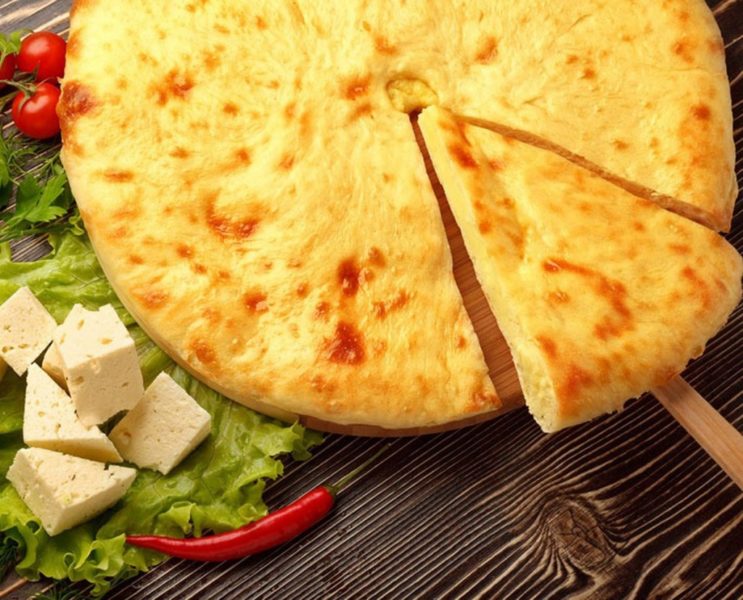
For a traditional recipe, we need:
- milk - 3 glasses (you can take goat, sheep, cow);
- 3 tbsp ghee;
- 2 tbsp. l yeast
- 1 tbsp. l Sahara;
- 1 tsp salts;
- 1-2 kg of feta cheese or any pickled cheese.
The most important thing is to knead the dough on the cakes correctly. To do this, sift flour through a sieve (leaving one glass for pouring), forming a small slide on the board or in the dishes. In the center of the slide we make a recess. We stir in a glass of warm milk, sugar, salt, butter and yeast, and then pour the mixture into the very center of the flour hill.
Thoroughly knead the components to a uniform consistency: it should be moderately viscous and not stick to the hands.Cover everything with a towel and leave the dough to approach in a warm place for about 2 hours. And only then it is important to thoroughly knead the dough, adding the rest of the flour and leave for another 30-40 minutes.
An important tip for everyone who decided to make pies for the first time: be sure to observe the proportions and sequence of actions! Then, when you “beat” your hand, the process will definitely go faster - you will learn how to feel the dough, which means you can change the proportions as you wish.
In the meantime, the dough is suitable, prepare the filling. Traditional pies - called "ulibah" and "habizdzhin" - are cooked with pickled cheese, which simply grates on a coarse grater. Cheese can be simply mashed so that it turns into a delicious cheese mass. It happens that the feta cheese is too salty: then it is soaked in water so that the excess salt is gone. If you see that the cheese is quite dense, but non-greasy in structure, add a little butter (just a couple of tablespoons). When the filling is ready, we begin to form cakes.
We roll the cake, evenly distributing the dough from the center to the edges. The thickness of the dough over the entire surface should be the same: about 1.5 cm. And now we spread the filling, evenly distributing it over the entire surface (we leave 3-4 cm at the edges for “tucks”). It remains to raise the edges and carefully pick them to the center, trying to fasten. It is better to leave a small hole in the center - this will leave the steam during cooking. It remains to carefully transfer the pies into the baking dish and slightly flatten, giving the shape of the cake. You can use a rolling pin, or do it with your hands - at your discretion.
The ideal diameter of the Ossetian pie is 30 cm.
It remains to grease the pies with yolk (you can have strong black tea), bake them at a temperature of 220 degrees for 15 minutes until golden. Ready-made pastries are abundantly poured with butter (sometimes replaced with heavy cream): it impregnates the dough, giving it a fantastic juiciness and creaminess. As soon as the oil is absorbed, you can eat the cakes. Try not to eat them with your hands!
Cooking with cheese at home
Once upon a time, cakes were baked without yeast, using only fresh dough. Now the recipe is much more reminiscent of Russian pies: the housewives put the dough on milk, yeast, adding egg and butter. It is also possible to experiment with cheese filling and replace Ossetian cheese with feta, feta cheese, Adyghe cheese, any kind of hard cheese, and they can be mixed in equal proportions.
For cooking:
- Knead the dough according to a traditional recipe.
- We mix feta, feta cheese, Adyghe cheese in a separate container.
- We cook Ossetian pies, baking for 40 minutes, until the cheese inside is melted.
Ossetian cheese pie is especially well combined with yoghurt, katyk, ayran. But in principle, you can replace it with kefir or whey, as you like.
With potatoes and cheese
A pie with cheese and potatoes is called “kotofjin” in Ossetia, and this kind of pies is very popular among the people. The secret is very simple: potatoes are easy to take with you as a snack, going to work or just on a long journey. Pies do not lose their charms neither in cold nor in hot form, so cakes are prepared very often.
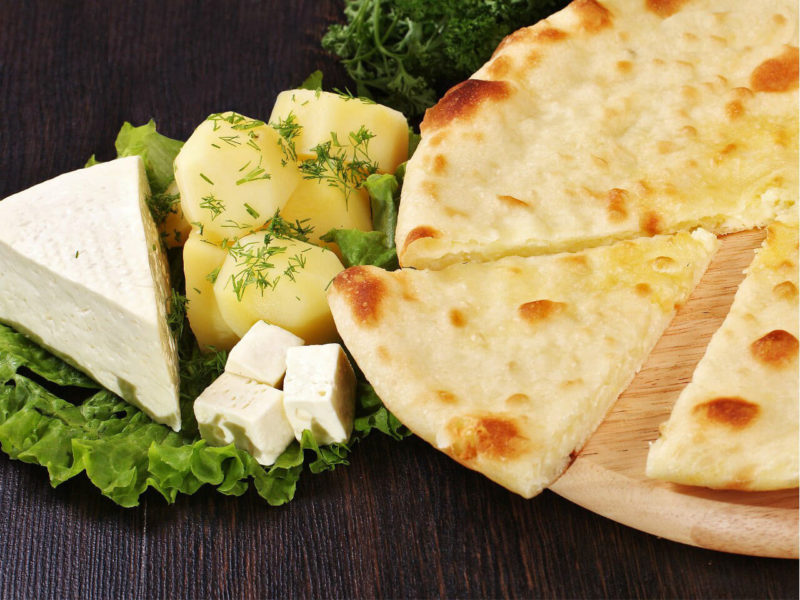
Pies are prepared very simply: for the filling, cheese and boiled mashed potatoes are mixed in equal proportions (you can make it on the water). The cheese should be sharp enough, otherwise the tortillas will turn out to be fresh. If you use salted feta cheese: you can not soak it, because the potato will absorb excess salt and it will be in moderation.
Bake at 200 degrees 30 minutes until the dough is ready. Lubricate the pies abundantly with melted butter. Serve with warm milk or tea.
Our secret! The fillings, according to the rules from Ossetia, should be exactly two times more than the dough, otherwise the dish will lose. And in the process of flattening the pies, it is important to ensure that the dough does not tear.
With green onions
Variation with green onions is called "Kadinjin".The combination of cheese and green onions is considered very successful: the onion gives additional juiciness and a spicy shade.
Ossetian cheese and onion pie is prepared in the same way as the previous options. But here it is important to choose the right bow: the feathers should be young, sweetish in taste, and in no case should be bitter: otherwise the pies will be overly “onion”. But the right greens will give a light “mushroom” flavor, especially if you add a little butter to the filling.
“Kadindzdzhiny” are very loved with spicy tea from mountain herbs, a bite with honey or other sweets.
With stewed cabbage
Cabbage in Ossetian is “cabbage”, so pies with cabbage and cheese are called “cabuskadjins” here. These cakes are baked in the season of young cabbage, which is lightly stewed in a pan, and then mixed with brine cheese.
The filling risks being fresh, and for this, black, red capsicum and other spices are necessarily added to it. An important nuance is to use young cabbage and stew it only in melted butter. If you take a winter variety, the taste of the pies will be completely different.
From tradition! In the homeland of pies on holidays they put three in a plate: three pies symbolize three elements. For the memorial table, there are always only two left on the table.
With chicken
The combination of cheese and chicken in itself is very tasty, and if you make it the filling of the Ossetian pie, you get a juicy, tender dish that children will like very much. For the test we use the classic recipe, but we’ll have to work hard on the filling.
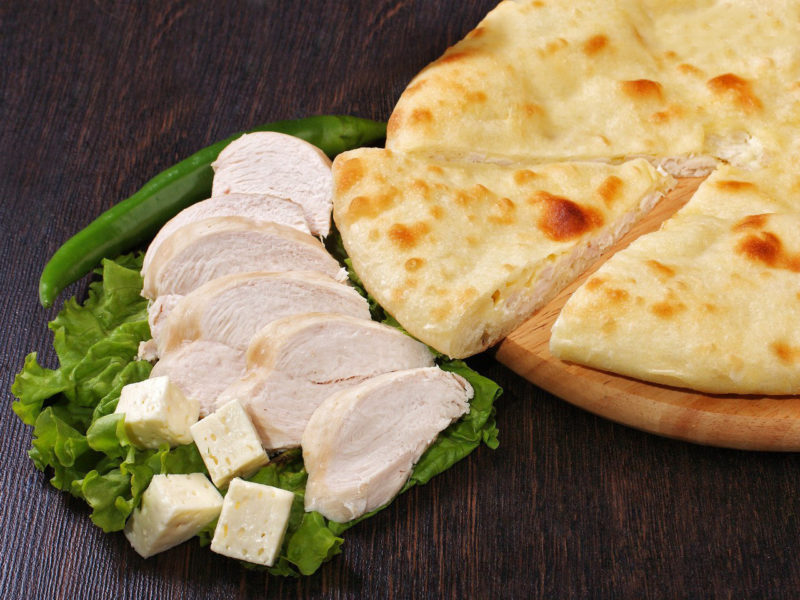
Make the filling like this:
- Finely chop the chicken into cubes and fry with onion in butter until half ready.
- Three warm pickled cheese in warm meat filling. Ideally, it should be feta cheese: feta will make the filling too salty, and Adyghe cheese - fresh.
- Season with any spices to taste.
- We make cakes.
- Bake them at 200 degrees for 30-40 minutes.
We grease the finished cake with oil and cover with a towel on top: it should slightly distance. This dish is ideal to drink young red wine.
Ossetian yeast pie with meat
Ossetian meat pie is called "fijin". It is always present at festive tables, being considered a solemn dish. But, as practice shows, such a dish can easily make a full and hearty dinner, feed even a large family.
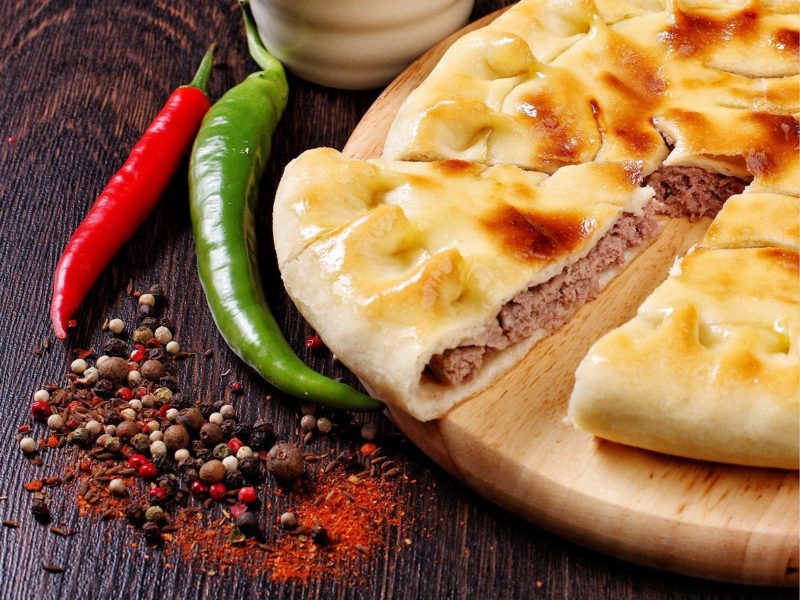
For cooking, we need:
- Any meat (preferably lamb, young veal).
- Brine cheese.
- One large onion.
- Butter.
Cooking the dough according to the basic recipe. We chop the meat into cubes, finely chop the onion, add cheese, grated butter. Cook the cakes and bake them at 220 degrees 40 minutes. Grease the finished meat pie with butter. Serve with spicy tomato sauce, herbs, fresh vegetables.
Stuffing for classic Ossetian pies is never used. The meat should be chopped into a small cube, no larger than half a centimeter.
With cottage cheese and herbs
Pies with herbs and cottage cheese are a budget and tasty version of classic pies. No need to look for special cheese: cottage cheese will give the desired acidity, piquancy, and greens - saturate the cake with a unique spicy aroma. You can use any herbs, but it is especially good to use cilantro, basil, and tarragon in this recipe. They give a special oriental flavor and taste.
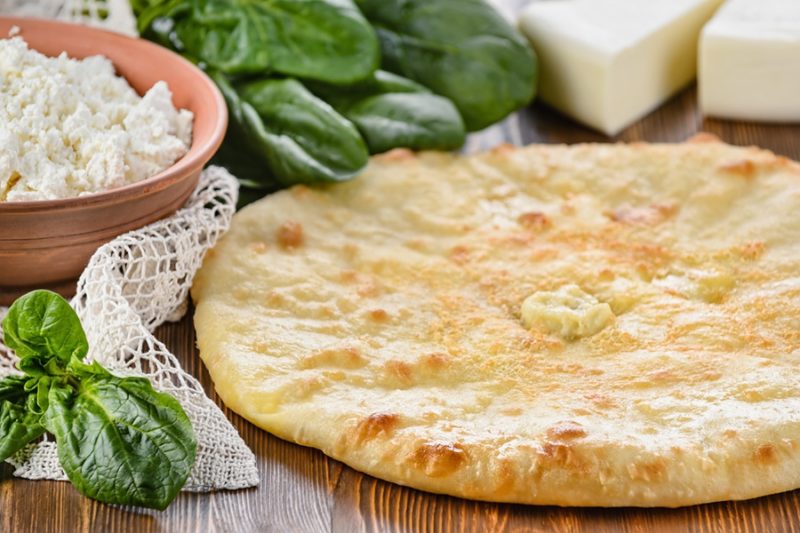
Cottage cheese needs to be mixed with greens, salt, mixed, so that the consistency of the filling is uniform. Next, lay out everything as in the classic recipe. Such cakes are baked a little faster - in just 15 minutes.
How to cook in a slow cooker?
Classical Ossetian pies are baked in special ovens, and cooking on open charcoals is considered chic. But modern housewives adapted the recipe, adapting it to multicookers.
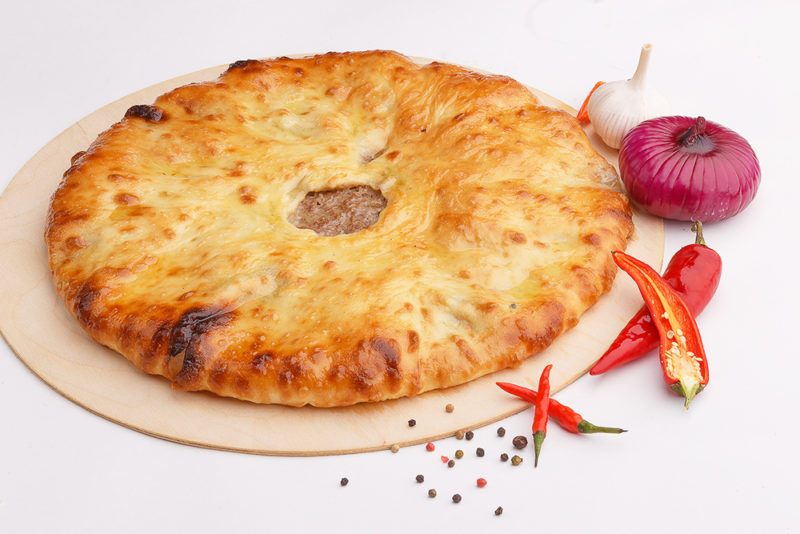
Plus such a dish, especially in the speed of cooking, and the smart device itself regulates the temperature and baking time. It is very simple to make pies, but here it is important to calculate the size of the cake for the diameter of the multi-bowl.Lubricate the bottom with oil, spread the cake, turn on the “Baking” mode and wait for the oven to signal the end of work. We eat a little cake with vegetables, washed down with strong aromatic tea with lemon and herbs.
The recipe for an Ossetian pie, if it seems laborious, is only for the first time: it is enough to bake it once, so that later you would like to repeat the dish again and again in different variations. Be bolder: use pumpkin, zucchini, grape leaves, beet tops, spinach and sorrel for the filling, experiment with different varieties of cheeses. We are sure that pies will surely take root in your diet and will gladly be eaten by households.






